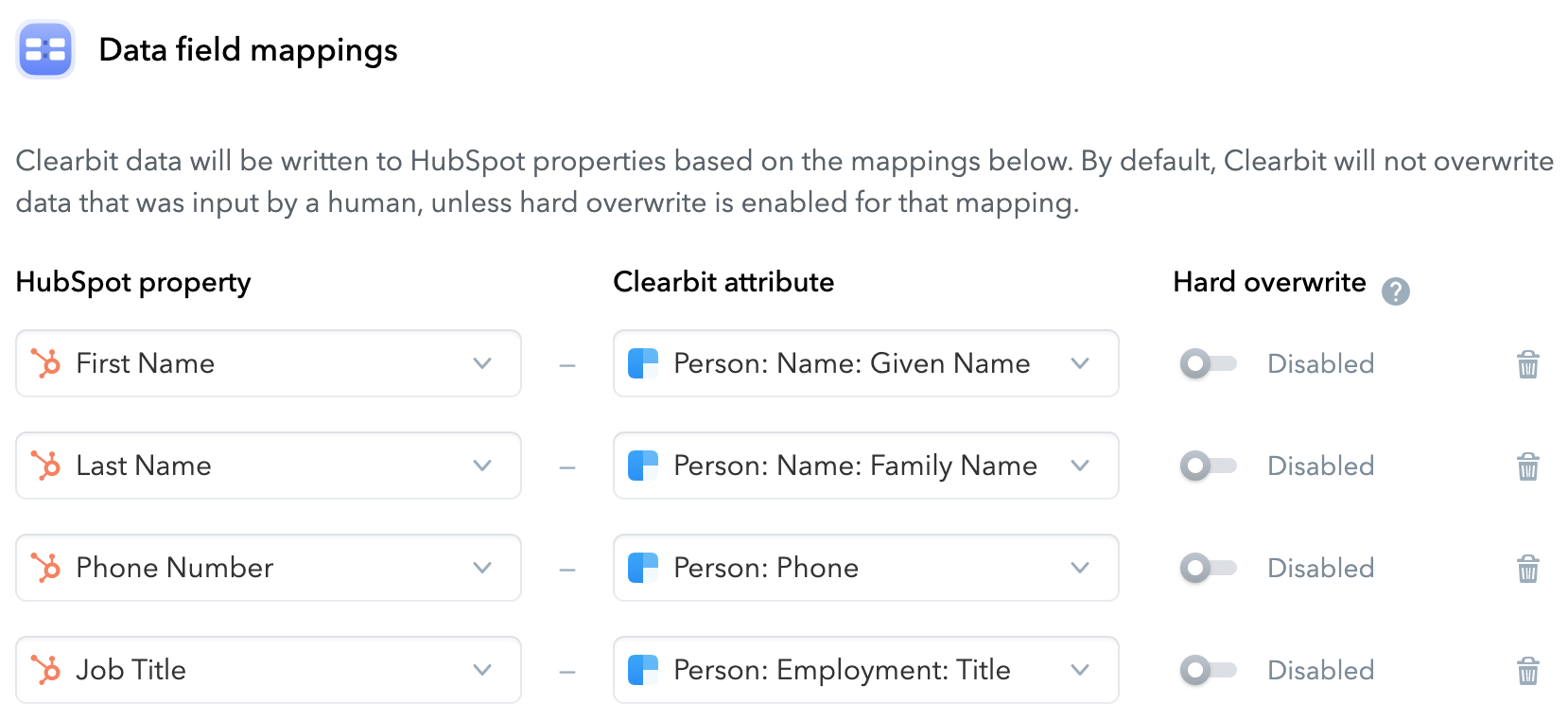How to create a better buyer experience with Clearbit and HubSpot

You can’t use the same messaging for everyone when you expand into new verticals or move upmarket. A good tech stack lets you automatically show unique content and copy to different customer segments — and the more data you feed your stack, the more segmentation options you’ll have.
When you enrich HubSpot with Clearbit data, you add over 100 business data attributes to your accounts and contacts, as well as website engagement data. This helps you understand who’s in your database, segment by who they are and what they’re doing, and show messaging that fits their profile and recent activity.
All your external-facing HubSpot touchpoints, from email campaigns and landing pages to chat and smart content, can draw on this data foundation to create a coordinated brand experience. HubSpot can also surface this data to your sales team, helping them save time and tailor their outreach in a way that’s attuned to everyone’s needs.
How to enrich your HubSpot database with Clearbit
1. Connect Clearbit and HubSpot
In Clearbit, go to the Connections tab, find HubSpot, and click Connect to authenticate your account (detailed instructions here).

Then, go to the Data Sync tab in Clearbit to get started with Enrichment setup, starting with field mapping for contacts and companies.
Select Clearbit attributes and map them to specific HubSpot fields (both standard and custom). You have full control over what Clearbit data to bring into HubSpot, and you can choose whether to overwrite HubSpot data on a field-by-field basis.

Clearbit mapping attributes include:
Firmographic and demographic enrichment data: The Clearbit Classic — over 100 business and person attributes from over 250 data sources.
Behavioral intent: Engagement with your website — for example, a company’s week-over-week engagement or their recency (via “last page visit” date). This onsite behavior helps you infer and act on purchase intent
Clearbit Audience inclusion: You can also create a HubSpot attribute that indicates whether a record is part of a Clearbit Audience — a group of individuals or companies that meet the Audience’s attribute and behavior criteria.
For example, you might have a Clearbit Audience called “Executives at Enterprises” for leaders at large companies who have recently entered your funnel (using Clearbit’s seniority and company size attributes). This would map to a HubSpot attribute so that those executives are labeled in your database.
2. Understand who your high-fit contacts and accounts are
Once Clearbit data is available across HubSpot, you can learn more about who’s in your pipeline. Segment your database, build custom HubSpot reports about personas, or start an ICP analysis to see what attributes your best customers share.
At the company level, Clearbit offers traditional segmentation attributes such as number of employees, industry, and HQ location. But you can also experiment with special attributes like annual revenue, funding raised, and technologies used (CRMs, analytics tools, email platforms, etc.). Get more granular than “industry” with Clearbit company tags and company descriptions.
At the contact level, you’ll be able to segment on data like role, team, seniority, and location.
HubSpot fields will refresh automatically when contacts change jobs or a company’s info changes.
You’ll also be able to see and segment on website visit recency and frequency.
3. Get ready to follow up with high-value leads
Now that you know who’s in your database, get ready to act by setting up HubSpot alerts, scoring, and lists.
Lead scoring: Flag leads who have high fit and/or intent, based on Clearbit firmographic and demographic attributes, HubSpot data, website behavior, and whether a lead or company belongs to a Clearbit Audience.
HubSpot alerts: Set up HubSpot alerts to notify when there’s an important change in Clearbit data that could affect your sales cycle with an open opportunity. For example, if you’ve been working on selling HR software to an account, and their HR manager gets promoted to VP of HR, it could be a good time to make sure you’re part of their new budget. You can also trigger HubSpot alerts when high-value accounts (based on Clearbit fit criteria) are showing intent on your HubSpot website.
HubSpot lists and Clearbit Audiences: Create HubSpot lists for different segments based on Clearbit attributes, which can then be used for personalization across email, webpages, and ad targeting. Or feed HubSpot data back to Clearbit to create Clearbit Audiences for targeted social ads, lead capture, and more. Combine HubSpot and Clearbit data sources to get to the exact audience you want, such as “companies in the US with 500–1,000 employees who converted on your HubSpot site in the last 6 months and have increasing week-over-week engagement.”

4. Put personalization in motion across your funnel
With rich fit and intent data, HubSpot can automatically serve up messaging that resonates with each of your major customer segments. For example:
- Write HubSpot email campaigns that get more opens and clicks
- Use HubSpot smart content modules that display different content across your blog posts and webpages, depending on which segment the viewer belongs to.
- Use Clearbit data in HubSpot chat for more tailored conversations
- Create personalized HubSpot landing pages that offer relevant information and CTAs
These personalizations will be based on the same clean, consistent Clearbit data, creating a relevant and unified brand experience for your leads as they travel down the funnel.


